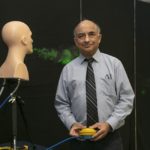
Florida Atlantic University’s College of Engineering and Computer Science has done studies to see how far a cough can travel. Health researchers and doctors have said the coronavirus is spread primarily by person-to-person transmission via tiny droplets, and they recommend staying 6 feet away from others. The FAU scientists say this may not be enough.
The scientists used a mannequin and simulated the cough particles with a mixture of water and glycerin which would be visible under laser light.
The study results: it only took the particles a couple of seconds to travel 3 feet; in about 12 seconds it reached 6 feet and in about 41 seconds it reached around 9 feet. A light cough will travel very little distance, but a heavy cough can travel at least 12 feet.
The scientists said the study reinforces how important it is to cough into one’s arm, to wear a mask to contain many of the droplets, and to stay at least 6 feet apart.
Click here to see the study data as well as a video that illustrates how far a cough can travel.
Photo, from the FAU press release, of Manhar Dhanak, Ph.D., a professor, chair of FAU’s Department of Ocean and Mechanical Engineering, and director of FAU’s SeaTech, in the laboratory where they conducted the simulation. (Photo by Alex Dolce)